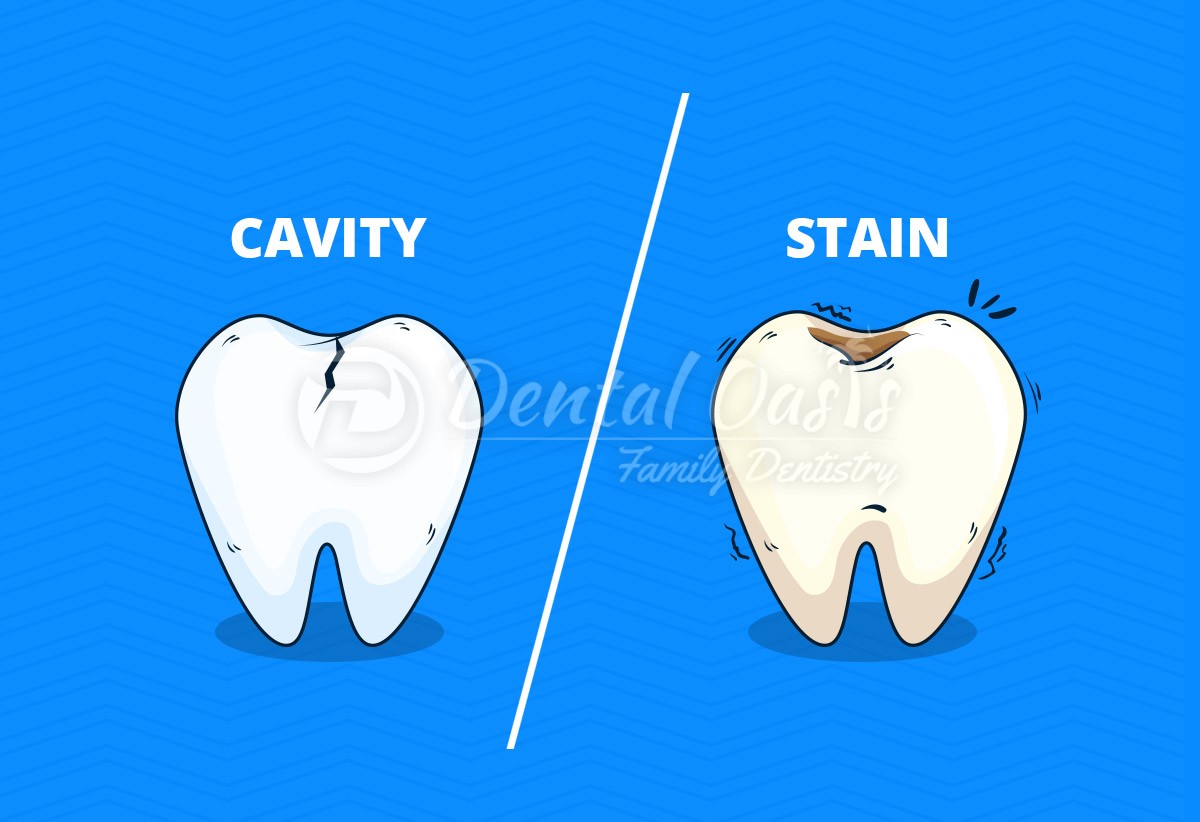Cavity vs Stain: Detection, Cause, and Prevention

Stains & Cavities impact your teeth in different ways. A cavity begins as a small hole in the tooth and can permanently damage the enamel if left unattended. An extrinsic stain, on the other hand, causes discoloration on the surface of the tooth. These are primarily caused on account of lifestyle issues & can mostly be corrected.
Stained teeth & cavities can have quite a similar appearance, though. How does one then tell the difference between the cavity and stain? Here is help.
What does a cavity look like vs stain?
- Is what you see appears as one spot on the tooth or is the entire tooth discolored? If your answer is that the issue is widespread, it is likely to be a stain.
- Do you see a single spot on the tooth, which is brown, black, gray in color? In such cases it is likely to be a cavity.
- Along with the spot on the tooth are you experiencing other symptoms? Like sensitivity in the tooth or pain in the tooth that even spreads to your jaw, ear, or cheek? In such cases, you likely have a cavity.
Causes of Cavity & Stains
Cause of Cavities
Frequent snacking and most importantly not maintaining oral hygiene are some of the factors that can lead to the formation of plaque on your teeth. The bacteria, in the plaque, in turn, produces acids that break down the enamel & forms a cavity. As the cavity deepens, you tend to experience several other symptoms such as:
- Toothache
- Sensitivity in the tooth
- Visible Holes
- Pain in biting down, and more
Cause of Tooth Stains
Typically tooth stains are caused on account of consumption of certain tooth & drinks such as tea, coffee, wine, chocolate, candies, pickles, soy sauce & more. In addition, smoking & the consumption of tobacco are also a major source of staining.
While the above factors are responsible for extrinsic tooth staining, in some cases, the tooth staining may also be intrinsic which implies that it is caused not by external agents but on account of intrinsic factors within the body. Certain treatments such as radiation & chemotherapy can also cause tooth discoloration. Similarly, certain medications such as tetracycline & Doxycycline can cause tooth discoloration in children. Tooth discoloration, on the other hand, sometimes, can also be age related as the enamel on the teeth tends to wear away with age. Trauma & damage from a fall, for example, could also lead to teeth discoloration.
How to prevent cavities and stains?
Overall, as the above information suggests, good oral hygiene is the key to keeping both cavities as well as stains at bay. Additionally, the following precautions will help you maintain your pearly whites
How to prevent cavities?
- Brush your teeth twice daily. Make sure you use a fluoride toothpaste
- Floss daily
- Stick to a healthy diet
- Ensure you have regular dental check-ups so that any issues can be identified early.
How to prevent tooth stains?
Tooth stains can be avoided by avoiding excess consumption of tea, coffee, wine, smoking & more. Drinking with a straw can also help keep stains away. Improving dental hygiene that comprises of brushing, flossing and using mouthwash daily is extremely important. Additionally, having your teeth cleaned by a dental hygienist every six months is recommended to remove any plaque or tartar.
Cavities Vs Stains – Treatment Options
Should you have developed cavities or stains, you need not worry as there are a few options available to treat them.
How are cavities treated?
1. Fluoride Treatment
Fluoride works by restoring minerals to the surface where the enamel is eroded. Additionally, it also restricts the growth of bacteria & therefore prevents more cavities from developing.
YOU MAY ALSO LIKE: Fluoride and Sealants – Powerful Cavity Fighters
2. Tooth Fillings
Tooth fillings are common treatments for cavities, this involves using material such as porcelain or composite resins to fill up the cavity.
3. Root Canal Treatment
In case the cavity has progressed to a point where the pulp of the tooth has been affected, a root canal treatment will be in order. This involves removing the affected pulp and cleaning the affected area. A filling is placed next to it & the area is sealed.
4. Tooth Extraction
In case the tooth cannot be saved even with a root canal treatment then tooth extraction may be the only option. Your dentist will be in the best position to suggest what replacement should be used for the extracted tooth so that the other teeth do not shift.
How to treat tooth stains?
There is a wide range of options when it comes to treating extrinsic tooth stains. These include:
1. In-office whitening procedures
Your dentist will help bleach your teeth. The process essentially involves applying a whitening agent to the teeth. Oftentimes special lighting is used that ensures great results. Alternatively, your dentist can also offer you a custom-fitted tray that you can safely use at home with a whitening gel.
2. Bonding
This involves fusing material to stained portions of the teeth so that the teeth can be brightened.
3. Dental Veneers
A very common cosmetic dentistry treatment, it involves fitting custom-made shells on the front surface of the teeth. Dental Veneers are of several different kinds including:
- Composite Veneers
- Porcelain Veneers
- Removable Veneers, and more.
If you have dental problems like cavities or tooth stains, then Dr. Sharda Patel can help you to improve your dental health. Dr. Sharda Patel is a Pleasanton-based dentist who provides general dental service and cosmetic dental service. Schedule a dental appointment now to make your teeth healthy.




